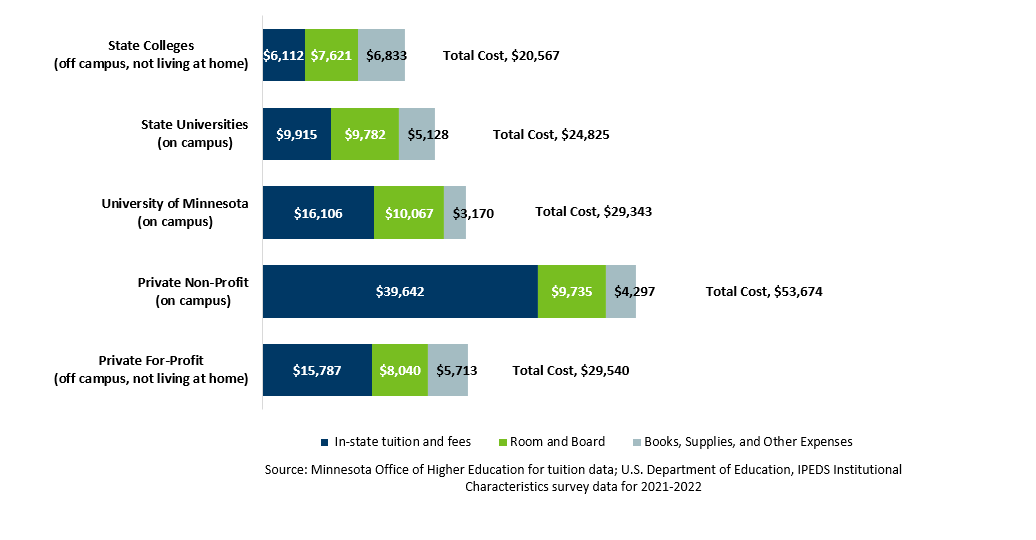What Does College Cost?
How much will it cost, anyway?
The costs to attend college for a full year go beyond the institution's advertised tuition. Don't forget there are additional room and board, books and supplies, personal and transportation expenses as well. The chart below shows the average annual full cost of attendance by type of college.
Don't let these costs scare you from determining your college choice. Costs of attendance vary by institution and within institutions and the final net cost you pay depends on any financial aid or institutional discounts you may receive. So, make sure you check what financial aid is available to help pay for college. Few students will be required to pay the full cost of attendance.
Learn more: Tips for Lowering the Cost of Higher Education
Average Annual Expense for a Resident Undergraduate Attending Full-Time at a Minnesota College, 2021-2022

Tuition data for 2021-2022 as used for state grant purposes.
Room and board and other expenses for 2021-2022.
Costs vary by institution. Look up current college costs for individual colleges on the College Navigator.
Source: Minnesota Office of Higher Education for tuition data; U.S. Department of Education, IPEDS Institutional Characteristics Survey for other data
Adding up the costs
Tuition and fees
Students pay tuition for classes and instruction provided by the college. In addition, there are fees automatically charged for services such as the health center, library or student activities.
Current tuition and fees
- Minnesota Tuition and Fees
- North Dakota Tuition and Fees
- South Dakota Tuition and Fees
- Wisconsin Tuition and Fees
Food and Housing
This refers to the basic price of living at the school during the academic year. "Housing" can be an on-campus dormitory or off-campus. "Food" refers to the price of eating, whether it's in the college cafeteria or buying food and preparing meals yourself.
Not all food and housing options are available at all schools. Many two-year schools do not have on-campus housing. Some larger schools only have college housing for undergraduates or only for first- and second-year students. Some colleges do not allow students to live off campus until their third or fourth year. Contact individual schools for specific details.
Books and supplies
Unlike in high school, students in college are expected to buy their own books. In addition, they're expected to purchase their own pencils, paper, art supplies, calculators and computer supplies - whatever they need to complete their courses.
Buying used textbooks can help students save money, and they may be available in the campus bookstore or from online used booksellers such as:
See also: Reducing Textbook Costs: Campus Strategies for Students, Faculty & Staff.
Personal expenses
Regardless of the type of institution the student chooses, they will have some personal expenses such as laundry, clothing, recreation, medical care, insurance and so on. Students should plan to spend at least $1,000 each academic year on these items.
Transportation expenses
All students spend some money for travel, whether they live on campus or commute to school daily. Students living on or near campus must travel there at the start of the school year and return home at the end. Most students also go home at least once during the year.
Commuter students who travel to and from the school on a daily basis must carefully figure in the cost of fuel and parking or public transportation. Both can add up quickly. The transportation costs for commuter students are also built into the financial aid calculations used by the school.
Most students are eligible for some type of financial aid
Minnesota students and families receive nearly $3.3 billion in financial aid or institutional discounts annually to help pay for college. The money comes from the state of Minnesota and the federal government, colleges, and private sources. There also are tax benefits and deductions that make what families have to pay more manageable.
Use the U.S. Department of Education's financial aid estimator to help gauge what it might cost your family to attend a college of your choice anywhere in the nation. The net price estimates how much it might really cost to attend a particular college depending on family income and subtracting any federal, state and institutional aid undergraduate students may receive.
Note: documents in Portable Document Format (PDF) require Adobe Acrobat Reader 5.0 or higher to view.
Quick Links
- Why College?
- Explore Your Interests & Careers
- Prepare at School
- Summer Academic Enrichment Program
- The Many Ways to Earn Credit for College
- Recommended High School Classes & Graduation Requirements
- Advice for Students with Disabilities
- Succeed as an Adult Student
- Useful College Prep Resources
- Minnesota Goes to College!
- Collecting Data from Minnesota Postsecondary Institutions
- Campus Financial Aid Administrator Resources
- Campus Student Enrollment Reporting Resources
- Ordering Materials for Your Students
- Supplementing Your College Counseling
- Early Awareness Efforts
- Student Homelessness in Higher Education Resources
- Shared Library Resources
- MN FAFSA Tracker
- Campus Sexual Violence Prevention and Response
- Statewide FAFSA Filing Goal
- MyHigherEd
- Online Applications
- About Financial Aid
- What Does College Cost?
- Tips for Lowering the Cost of Higher Education
- Institutional Payments
- Financial Aid You Don't Repay
- Financial Aid You Must Repay (Student Loans)
- Financial Aid You Earn
- Military Service Education Benefits
- Reduced Out-of-State Tuition Options
- Education Tax Benefits
- Public Service Loan Forgiveness
- Ready, Set, FAFSA!
- North Star Promise
- Minnesota Paramedic Scholarship
- Data Maps and Infographics
- Educational Attainment Goal 2025
- Minnesota P-20 Statewide Longitudinal Education Data System
- Minnesota Measures
- Student Enrollment Data
- College Readiness & Participation Data
- Degrees, Graduation Rates, Attainment & Outcomes
- Tuition & Fees Data
- Student Health and Safety
- Financial Aid Data & Trends
- Institution and Data Search
- Transfer Students
- Research Reports
- A-Z Data Table Index
- Postsecondary Funding
- Special Student Populations
